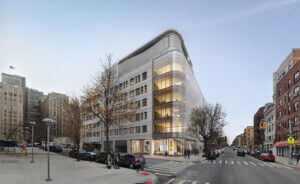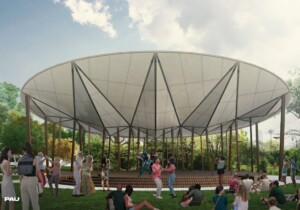Last month’s court victory for opponents of Columbia University’s new campus in Manhattanville was not necessarily a defeat for the school’s planned 17-acre expansion, and not only because appeals remain. With roughly 94 percent of the area under its control, Columbia has said it plans to continue work on the campus, despite its insistence that it cannot be completed as planned without full control of all buildings therein. Last night, Columbia officials outlined their current approach to Manhattanville for the first time since the ruling at a hearing in Harlem on the future of eminent domain in the state (more on that in Issue 1!).
After an hour-and-a-half of grilling the ESDC—the state agency responsible for pursuing eminent domain on Columbia’s behalf— State Senator Bill Perkins, in whose district the project lies, set his sights on Marcello Valez, the head of construction for the Manhattanville project at Columbia, and Maxine Griffith, a former planner who is now in-charge of government affairs at the school. The pair were evasive on many issues surrounding eminent domain and the court case—technically, they are responsible for neither—but they outlined their utility, demolition, and construction work that has been ongoing for a few months now.
Most notably, 3229 Broadway continues to come down. It was the former building of Ann Whitman, one of the last remaining hold outs who eventually sold to the school in 2008 because she said she could no longer afford to fight. Her plot and an adjacent gas station will soon become home to the Jerome L. Greene Science Center, a major neuroscience project that, at the corner of 129th Street and Broadway, is supposed to be one of the new campus’ centerpieces. Work will also soon commence on an art building also on the block and, perhaps most importantly, the entry to the subterranean “bathtub,” that, World Trade Center-style, will house most of the campus’ infrastructure.
The bathtub remains a crucial piece of the Manhattanville puzzle because it is part of the justification for seizing the remaining properties. “If the basement can’t connect, it would be difficult to see how the project could move forward,” Griffith said, arguing the campus would be much less pedestrian friendly and community accessible with trucks idling on the street and HVAC spewing into the air. (A member of the Coalition to Preserve Community, a local opposition group, argued it was all a planning ruse, with the school fully able to build around the holdouts.)
As for timing, Valez said that, despite the court case, everything remains on time, which is part of the reason construction work must continue on those properties controlled by Columbia. (That and the donors are old and would like to see something built while they’re still alive, Griffith admitted somewhat cheekily.) As for architecture, Renzo Piano is nearing completion on final designs for these two buildings according to Victoria Benitez, a university spokesperson in attendance last night, though no renderings are yet available. She declined to say whether the Genoan architect would be designing the rest of the buildings on campus or whether some might go to other firms.










